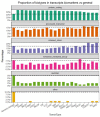TranscriptAchilles: a genome-wide platform to predict isoform biomarkers of gene essentiality in cancer
- PMID: 30942869
- PMCID: PMC6446222
- DOI: 10.1093/gigascience/giz021
TranscriptAchilles: a genome-wide platform to predict isoform biomarkers of gene essentiality in cancer
Abstract
Background: Aberrant alternative splicing plays a key role in cancer development. In recent years, alternative splicing has been used as a prognosis biomarker, a therapy response biomarker, and even as a therapeutic target. Next-generation RNA sequencing has an unprecedented potential to measure the transcriptome. However, due to the complexity of dealing with isoforms, the scientific community has not sufficiently exploited this valuable resource in precision medicine.
Findings: We present TranscriptAchilles, the first large-scale tool to predict transcript biomarkers associated with gene essentiality in cancer. This application integrates 412 loss-of-function RNA interference screens of >17,000 genes, together with their corresponding whole-transcriptome expression profiling. Using this tool, we have studied which are the cancer subtypes for which alternative splicing plays a significant role to state gene essentiality. In addition, we include a case study of renal cell carcinoma that shows the biological soundness of the results. The databases, the source code, and a guide to build the platform within a Docker container are available at GitLab. The application is also available online.
Conclusions: TranscriptAchilles provides a user-friendly web interface to identify transcript or gene biomarkers of gene essentiality, which could be used as a starting point for a drug development project. This approach opens a wide range of translational applications in cancer.
Keywords: RNA-sequencing; RNAi screen; alternative splicing; biomarker; cancer; gene essentiality; precision medicine; transcriptomics; web tool.
© The Author(s) 2019. Published by Oxford University Press.
Figures






References
-
- Sveen A, Kilpinen S, Ruusulehto A, et al. .. Aberrant RNA splicing in cancer; expression changes and driver mutations of splicing factor genes. Oncogene. 2015;35:1–15. - PubMed
Publication types
MeSH terms
Substances
LinkOut - more resources
Full Text Sources

